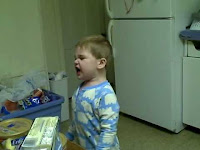When using words and phrases to teach new behaviors to your child with High-Functioning Autism, it will be crucial to develop and write them down on a poster board or white board.
These words and phrases will be used when introducing or generalizing new behaviors to your child. By making them visual, you guarantee both greater understanding and usage of them.
Strange phrases or catchy sayings are often attractive and easy to remember, but actually using the words and phrases - not simply writing them down – is what makes them effective. Also, they should be developed by you AND your youngster, which will increase the likelihood that they will be remembered.
The steps to creating a list of key words and phrases:
- Choose the area you want to work on with your youngster.
- Select (or have your youngster select) a word or phrase to be used as a quick reminder for appropriate responding.
- Teach your child to use the key words and/or phrases as needed. With consistent use, they will convey the concept and what appropriate responding will look like. This will allow your youngster to generalize a skill more easily. When the phrase is used in a new situation, he or she will know what to do, because the phrase corresponds to the new behavior.
- After one key word or phrase has been mastered, add others as needed.
==> Teaching Social Skills and Emotion Management to Children and Teens with High-Functioning Autism
Below is a sample list of words and phrases that other parents have found to be effective. It would be daunting to try and teach your child all of these. Thus, simply pick two or three to start with, and then branch out from there over the course of several weeks or months.
- Use your words (i.e., controlling yourself by using words when you are upset or frustrated, rather than responding with a tantrum or meltdown)
- This is a choice – or – This is not a choice
- Thinking with your eyes (i.e., learning to use your eyes to communicate)
- Thinking with your body (i.e., learning to use your body to communicate)
- Another way (e.g., used to let the youngster know that you don't like the behavior or tone of voice he/she is using, for example, "Can you try another way of saying that?")
- The rule (it’s helpful for the youngster to have appropriate responses described as “the rule”; it appeals to his/her sense of seeing the world in black and white; often simply stating that a desired response is "the rule" brings immediate compliance)
- The preschool way, the elementary school way, etc.
- That doesn't make sense (i.e., used when the youngster says something that is inappropriate, for example, fantasy talk, mislabeling another's or their own feelings, giving misinformation on a topic, etc.)
- Tell me what you have to do (e.g., often used after giving directions)
- Switching – or – substitutions (i.e., key words used to remind the youngster about being flexible)
- Stretching the topic (i.e., attempting to go off topic by trying to make your new topic – usually a special interest – appear related to the original topic)
- Stick up for yourself (i.e., refers to the type of response the youngster must make when being teased or taken advantage of by others)
- Show me (i.e., add the phrase for what you want the youngster to do)
- School sitting, school walking, etc. (i.e., refers to a specific manner of doing something that has been demonstrated to the youngster previously)
- Say one thing (i.e., when answering questions or discussing a topic with too much detail – this skill should be practiced)
- Salvage the rest of the day (i.e., refers to not allowing a problem to ruin the rest of the day)
- Respond Quickly and Quietly (referred to as Q and Q)
- Problems and Solutions (i.e., refers to a technique used to either prevent a tantrum or assist the youngster in regaining control during a tantrum; referred to as P and S)
- Personal space (i.e., not touching others when it is not appropriate)
- Off the topic (i.e., said to the youngster when his or her response is not on the topic being discussed)
- MYOB ("mind your own business")
- Lower – or – raise your volume (i.e., to help the youngster to modulate voice volume; often paired with a hand signal)
- Look and Listen (referred to as L and L)
- KISS ("keep it small and simple")
- Keep your problems small (i.e., used when the youngster's behaviors are just beginning to escalate in a negative way; serves as a reminder to maintain control)
- Just do it (i.e., refers to times when the youngster must quickly respond in a particular way without question)
- In your head (i.e., refers to statements that should not be said aloud, usually statements about a person's physical appearance or statements that would hurt another's feelings)
- Good choice – or – bad choice
- Get your control (i.e., key phrase used during a crisis)
- Eyes up here (i.e., key phrase to help with attending and focusing)
- Drop the subject (i.e., refers to talking on and on)
- Don't get stuck (i.e., refers to not allowing a problem to control you or stop you from moving on; this skill is taught)
- Don't be a "me first" (i.e., used with those kids who have an obsession about always being first in line, when playing a game, being called on, etc.)
- Dealing with disappointments (i.e., refers to what to do when something doesn't go the way we thought it would)
- Conversations go back and forth (i.e., used as a reminder when learning how to converse with others)
- Bumping (i.e., refers to interrupting others when they are speaking)
- Being okay (i.e., getting yourself together to handle a situation)
- Being flexible (i.e., used when the child is upset with a routine change)
What moms and dads say is important, but “how” they say it can make the difference between compliance and noncompliance in their child on the autism spectrum. Sometimes a quiet, calm voice is needed. At other times, a firmer tone may be called for.
When you change the tone of your voice, point it out to your youngster. Kids on the spectrum don’t usually use varied tones of voice to convey different meanings. By pointing this out, you communicate your meaning, and you increase your child’s awareness of the importance of paying attention to vocal tone.
Also, this should be done with facial expressions and body language – two other things kids on the spectrum don't use when communicating to - or processing communication from - others. Vary your facial expressions and body language, and explain/show how it helps people to understand what others are saying.
Resources for parents of children and teens on the autism spectrum:
==> How to Prevent Meltdowns and Tantrums in Children with Autism Spectrum Disorder
==> Parenting System that Reduces Defiant Behavior in Teens with Autism Spectrum Disorder
==> Launching Adult Children with Autism Spectrum Disorder: Guide for Parents Who Want to Promote Self-Reliance
==> Teaching Social-Skills and Emotion-Management to Children with Autism Spectrum Disorder
==> Parenting Children and Teens with High-Functioning Autism: Parents' Comprehensive Handbook
==> Unraveling the Mystery Behind High-Functioning Autism: Audio Book
==> Parenting System that Reduces Defiant Behavior in Teens with Autism Spectrum Disorder
==> Launching Adult Children with Autism Spectrum Disorder: Guide for Parents Who Want to Promote Self-Reliance
==> Teaching Social-Skills and Emotion-Management to Children with Autism Spectrum Disorder
==> Parenting Children and Teens with High-Functioning Autism: Parents' Comprehensive Handbook
==> Unraveling the Mystery Behind High-Functioning Autism: Audio Book
More articles for parents of children and teens on the autism spectrum:
Social rejection has devastating effects in many areas of functioning.
Because the ASD child tends to internalize how others treat him,
rejection damages self-esteem and often causes anxiety and depression.
As the child feels worse about himself and becomes more anxious and
depressed – he performs worse, socially and intellectually.
Click here to read the full article…
Click here to read the full article…
---------------------------------------------------------------
Meltdowns are not a pretty sight. They are somewhat like overblown
temper tantrums, but unlike tantrums, meltdowns can last anywhere from
ten minutes to over an hour. When it starts, the Asperger's or HFA child
is totally out-of-control. When it ends, both you and your child are
totally exhausted. But... don’t breathe a sigh of relief yet. At the
least provocation, for the remainder of that day -- and sometimes into
the next - the meltdown can return in full force.
Click here for the full article...
Click here for the full article...
--------------------------------------------------------------
Although Aspergers [high-functioning autism] is at the milder end of the
autism spectrum, the challenges parents face when disciplining a
teenager on the spectrum are more difficult than they would be with an
average teen. Complicated by defiant behavior, the teen is at risk for
even greater difficulties on multiple levels – unless the parents’
disciplinary techniques are tailored to their child's special needs.
Click here to read the full article…
Click here to read the full article…
------------------------------------------------------------
Your older teenager or young “adult child” isn’t sure what to do, and
he is asking you for money every few days. How do you cut the purse
strings and teach him to be independent? Parents of teens with ASD face
many problems that other parents do not. Time is running out for
teaching their adolescent how to become an independent adult. As one
mother put it, "There's so little time, yet so much left to do."
Click here to read the full article…
Click here to read the full article…
------------------------------------------------------------
Two traits often found in kids with High-Functioning Autism are
“mind-blindness” (i.e., the inability to predict the beliefs and
intentions of others) and “alexithymia” (i.e., the inability to
identify and interpret emotional signals in others). These two traits
reduce the youngster’s ability to empathize with peers. As a result, he
or she may be perceived by adults and other children as selfish,
insensitive and uncaring.
Click here to read the full article...
Click here to read the full article...
------------------------------------------------------------
Become an expert in helping your child cope with his or her
“out-of-control” emotions, inability to make and keep friends, stress,
anger, thinking errors, and resistance to change.
Click here for the full article...
------------------------------------------------------------
A child with High-Functioning Autism (HFA) can have
difficulty in school because, since he fits in so well, many adults
may miss the fact that he has a diagnosis. When these children display
symptoms of their disorder, they may be seen as defiant or disruptive.













